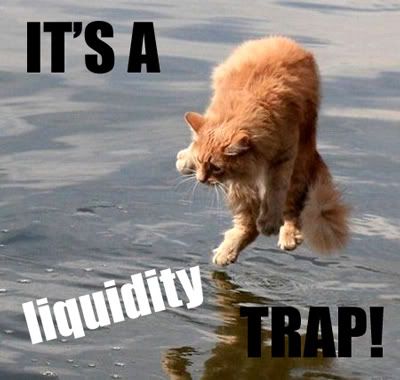Here’s an interesting article on the "Liquidity Trap" and what that means, published in the NY Times’ Economix blog section. 
Will Paulson’s Two Plans Unplug the ‘Liquidity Trap’?
Excerpt: "Editor’s note: Mark Sunshine, president of the commercial lending institution First Capital, writes a guest post about why we may be heading into what’s called a liquidity trap. This means that monetary policy, including interest-rate changes, can’t prevent a deep depression, but that the Treasury’s fiscal stimulus plans – including a little-noticed tax change pushed through last week – just might work."
"Anyone who reads newspapers or watches TV knows that the banking system is in crisis. Credit is tight, banks are hoarding cash and short-term Treasury yields are almost 0 percent. The Fed has lost its ability to unfreeze the system and the normal circulation of money isn’t happening. Almost all of the monetary signs point to a potentially terrible new phase of deflation and dramatic economic contraction.
This week’s Fed monetary report showed that during the week ending Sept. 22, money supply (as measured by seasonally adjusted M2) increased by $165.5 billion to $7,900 billion. On an annualized basis this is an astonishing 108.94 percent growth rate. The Fed has been aggressively pumping money into the system in the hopes that radical monetary stimulus will restart lending. However, the newly created money is being hoarded by banks as they “stuff the mattress” with short-term Treasury notes. 
Here’s why these events are distressing: When the Fed douses the monetary system with cash but banks hoard it, monetary policy no longer works and the economy starts to crash. This is called a “liquidity trap” and it occurs when interest rates are at or close to 0 percent and monetary policy is no longer effective. Newly minted money is injected into the banking system but trapped by financial institutions that are paralyzed by fear...
…The liquidity trap has neutered the Fed and its chairman, Ben Bernanke, because there isn’t much that the Fed can do with money supply or interest rates to make things better (despite reports that the Fed may cut interest rates again soon). Only fiscal stimulus – tax cuts or government spending hikes intended to increase demand — will unplug the system….
…But Mr. Paulson’s fiscal-stimulus work didn’t end with the bailout bill.
With hardly anyone noticing, on Wednesday he pushed through very technical and obscure changes to tax regulations that provide a “tax subsidy” for acquirers of troubled banks. Just as automakers stimulate car sales through rebate checks, the Treasury is providing a form of tax rebate to acquirers of troubled banks. Everyone can thank Hank Paulson and his stealth tax-driven fiscal stimulus for the astonishing news that Wachovia was being acquired by Wells Fargo and not Citigroup. It was Mr. Paulson’s tax subsidy to Wells Fargo that provided the fiscal grease to make this deal happen. Pundits who point to the deal and proclaim that the “free markets work without government help” don’t understand the motivating effect of several billion dollars of tax benefits to Wells Fargo.
Hopefully Mr. Paulson’s fiscal moves will provide enough fiscal laxative to unplug the banking sector and get money flowing again…"
Full article here.


